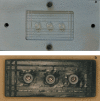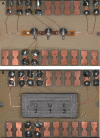Machined and plastic copings in three-element prostheses with different types of implant-abutment joints: a strain gauge comparative analysis
- PMID: 20856998
- PMCID: PMC5349059
- DOI: 10.1590/s1678-77572010000300005
Machined and plastic copings in three-element prostheses with different types of implant-abutment joints: a strain gauge comparative analysis
Abstract
Objective: Using strain gauge (SG) analysis, the aim of this in vitro study was quantify the strain development during the fixation of three-unit screw implant-supported fixed partial dentures, varying the types of implant-abutment joints and the type of prosthetic coping. The hypotheses were that the type of hexagonal connection would generate different microstrains and the type of copings would produce similar microstrains after prosthetic screws had been tightened onto microunit abutments.
Materials and methods: Three dental implants with external (EH) and internal (IH) hexagonal configurations were inserted into two polyurethane blocks. Microunit abutments were screwed onto their respective implant groups, applying a torque of 20 Ncm. Machined Co-Cr copings (M) and plastic prosthetic copings (P) were screwed onto the abutments, which received standard wax patterns. The wax patterns were cast in Co-Cr alloy (n=5), forming four groups: G1) EH/M; G2) EH/P; G3) IH/M and G4) IH/P. Four SGs were bonded onto the surface of the block tangentially to the implants, SG 1 mesially to implant 1, SG 2 and SG 3 mesially and distally to implant 2, respectively, and SG 4 distally to implant 3. The superstructure's occlusal screws were tightened onto microunit abutments with 10 Ncm torque using a manual torque driver. The magnitude of microstrain on each SG was recorded in units of microstrain (µε). The data were analyzed statistically by ANOVA and Tukey's test (p<0.05).
Results: Microstrain values of each group were: G1= 338.1 ± 223.0 µε; G2= 363.9 ± 190.9 µε; G3= 415.1 ± 53.5 IE; G4= 363.9 ± 190.9 µε. No statistically significant difference was found between EH and IH, regardless of the type of copings (p>0.05). The hypotheses were partially accepted.
Conclusions: It was concluded that the type of hexagonal connection and coping presented similar mechanical behavior under tightening conditions.
Figures






References
-
- Assif D, Marshak B, Schmidt A. Accuracy of implant impression techniques. Int J Oral Maxillofac Implants. 1996;11(2):216–222. - PubMed
-
- Byrne D, Houston F, Cleary R, Claffey N. The fit of cast and premachined implant abutments. J Prosthet Dent. 1998;80(2):184–192. - PubMed
-
- Carr AB, Brunski JB, Hurley E. Effects of fabrication, finishing and polishing procedures on preload in protheses using conventional "gold" and plastic cylinders. Int J Oral Maxillofac Implants. 1996;11(5):589–598. - PubMed
Publication types
MeSH terms
Substances
LinkOut - more resources
Full Text Sources
Miscellaneous

